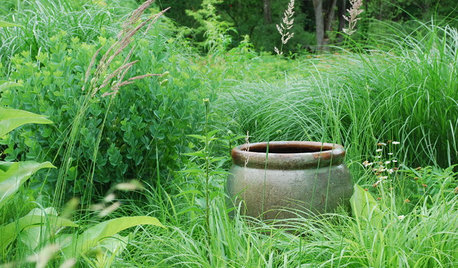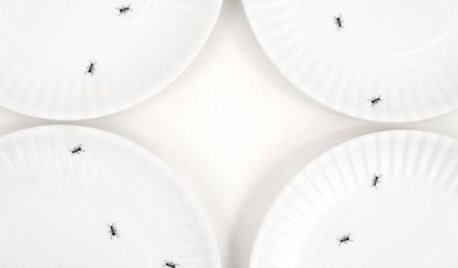Giant weed that can cause blindness popping up in Ontario, B.C.
Conservation Lands Planner Victoria Maines, left, and Natural Heritage Ecologist Charlotte Cox walk through a patch of giant hogweed in Terra Cotta, Ont. on Monday, July 20, 2009. From poison ivy to wild parsnip to giant hogweed, noxious plants have the potential to make nature-lovers cringe in fear. Darren Calabrese/The Canadian Press
Officials scrambling to destroy the plant that can also cause burns and permanent scarring.
Article
Ciara Byrne
Toronto The Canadian Press Published on Friday, Jul. 09, 2010 5:26PM EDT Last updated on Friday, Jul. 09, 2010 5:57PM EDT
A weed that can grow six metres(over 12 feet) tall, sprout massive leaves and produce toxic, blindness inducing sap is creeping into Ontario and parts of British Columbia.
Giant hogweed is easily identified by its teetering height. The leaves on the weed fan out as much as 1.5 metres(about 6 feet)in diameter. It is also identified by its tell-tale purple splotching on the stem and its umbrella-like cluster of white flowers.
The plant, which was spotted around the coast in British Columbia in late June, and is known to flourish in the Lower Mainland, Fraser Valley, Gulf Islands, and central to southern Vancouver Island, was discovered in the Renfrew County (near where I live, and it have been found in my county, Lanark) area in eastern Ontario on Thursday.
Jeff Muzzi, a manager of forestry services for Renfrew County, said officials have destroyed the toxic vegetation, but he said the indomitable weed has become a problem for other places in the province, including southwestern Ontario.
"It's giant. It's not a misnomer," said Mr. Muzzi as he explained the wondrous plant the seems to sprout in waste land areas, like ditches and vacant lots.
David Galbraith, head of science at the Royal Botanical Gardens in Hamilton said he was intrigued by the enormous plant  which is part of the carrot family  when he saw a huge patch growing behind a gas station north of the Goderich, Ont. years ago.
"I thought it was the most amazing thing I'd ever seen, a great, big, huge spectacular plant," said Mr. Galbraith as he explained its allure.
While it may look bewildering  almost begging to be examined by an amateur botanist or a green thumb  the consequences of touching the weed could scar a person for life.
"The sap gets activated by sunlight, so once you get out on the sun it reacts and can cause really bad burns, blistering and scars," said Mr. Muzzi.
It has also been known to cause temporary blindness or, in extreme cases, permanent loss of eyesight, said Mr. Muzzi.
Within 24 to 48 hours after a person comes in contact with the sap, the symptoms will begin to appear, he added.
The challenge is trying to uproot and remove the invasive weed, a careful task Mr. Muzzi tackled on Thursday.
"In the 35 degree heat I was snipping the flower heads off and I was wearing a Tyvex suit and eye protection," said Mr. Muzzi.
It may seem extreme, but it's exactly what the Invasive Plants Council of British Columbia recommends an expert wear when they're removing the worrisome weed. The council recommends waterproof gloves, a rubber raincoat and pants and eye protection.
Gail Wallin, the executive director of the council, said the weed has become dense and has recently spread on Vancouver Island.
"It's the one plant that in the last month I've received scads of calls," said Ms. Wallin.
Its large roots make it difficult to dig up, and after it's removed some experts suggest mowing the patch it was nestled on for several years to eliminate seeds in the soil.
Given that giant hogweed can produce more than 100,000 seeds, there is the potential that it will spread, said Mr. Muzzi.
Mr. Muzzi also said chemical herbicides can remove the plant, but since the cosmetic pesticide ban came into effect in Ontario, people have become wary of using any chemicals on plants.
Experts believe it was brought from Asia to England, and then into North America as an ornamental plant, and quickly flourished in wet, moist areas without a natural enemy.
Mr. Galbraith said the giant hogweed is an example of what happens when people introduce foreign plants into a garden.
"As an example of this problem, it's a spectacular one," said Mr. Galbraith.














daislander
DYH
Related Discussions
Weird anti-worm post I read today
Q
Spider ID (pix attached)?
Q
A sad day...
Q
blah, we have antts in the kitchen
Q
thinman
midnightsmum (Z4, ON)Original Author
gldno1
lavender_lass
ianna
parker25mv
aftermidnight Zone7b B.C. Canada
floral_uk z.8/9 SW UK